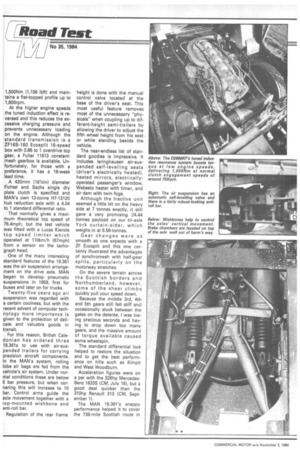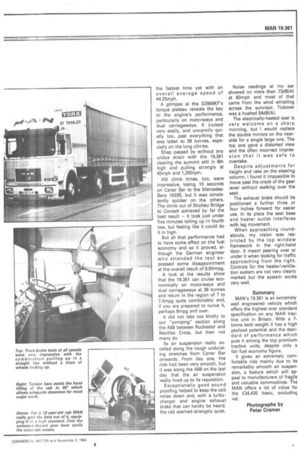Road Test
Page 32

Page 33

If you've noticed an error in this article please click here to report it so we can fix it.
1,500Nm (1,106 Ibft) and maintains a flat-topped profile up to 1,60Orpm.
At the higher engine speeds the tuned induction effect is re versed and this reduces the ex cessive charging pressure and prevents unnecessary loading on the engine. Although the standard transmission is a ZF16S-160 Ecosplit 16-speed box with 0.85 to 1 overdrive top gear, a Fuller 11613 constantmesh gearbox is available. Un fortunately, for those with a preference, it has a 16-week lead time.
A 420mm (161/2in) diameter Fichte! and Sachs single dry plate clutch is specified and MAN's own 13-tonne H7-13120 hub reduction axle with a 4.04 to 1 standard differential ratio.
That normally gives a maximum theoretical top speed of 76.4mph, but the test vehicle was fitted with a Lucas Kienzle top speed limiter which operated at 110km/h (67mph) from a sensor on the tachograph head.
One of the many interesting standard features of the 19.361 was the air suspension arrangement on the drive axle. MAN began to develop pneumatic suspensions in 1959, first for buses and later on for trucks.
Twenty-five years ago air suspension was regarded with a certain coolness, but with the recent advent of computer technology more importance is given to the protection of delicate and valuable goods in transit.
For this reason, British Caledonian has ordered three 19.361s to use with air-sus pended trailers for carrying precision aircraft components.
In the MAN's system, rolling lobe air bags are fed from the vehicle's air system. Under nor mal conditions these are below 6 bar pressure, but when cornering this will increase to 10 bar. Control arms guide the axle movement together with a top-mounted wishbone and anti-roll bar. height is done with the manual control valve located at the base of the driver's seat. This most useful feature removes most of the unnecesssry "physicals" when coupling up to different-height semi-trailers by allowing the driver to adjust the fifth wheel height from his seat or while standing beside the vehicle.
The near-endless list of standard goodies is impressive. It includes lsringhausen air-suspended self-levelling seats (driver's electrically heated), heated mirrors, electricallyoperated passenger's window, Webasto heater with timer, and air dam with twin fogs.
Although the tractive unit seemed a little bit on the heavy side at 7 tonnes exactly, it still gave a very promising 24.44 tonnes payload on our tri-axle York curtain-sider, which weighs in at 6.56 tonnes.
Gear changes were as smooth as one expects with a ZF Ecosplit and this one certainly illustrated the advantages of synchromesh with half-gear splits, particularly on the motorway stretches.
On the severe terrain across the Scottish borders and Northumberland, however, some of the sheer climbs quickly pull your speed down.
Because the middle 3rd, 4th and 5th gears still felt stiff and occasionally stuck between the gates on the detente, I was losing precious seconds and hay.. ing to drop down too many gears, and the massive amount of torque available caused some wheelspin.
The standard differential lock helped to restore the situation and to get the best performance on hills such as Kilnpit and West Woodburn.
Acceleration figures were on a par with the 326hp MercedesBenz 1633S (CM, July 16), but a good deal quicker than the 310hp Renault 310 (CM, September 1).
The MAN 19.361's snappy performance helped it to cover the 736-mile Scottish route in the fastest time yet with an overall average speed of 44.25mph.
A glimpse at the D2866KF's torque plateau reveals the key to the engine's performance, particularly on motorways and dual carriageways. It cruised very easily, and uncannily quietly too, past everything that was laden to 38 tonnes, especially on the long climbs.
Shap passed by without any undue strain with the 19.361 clearing the summit still in 8th high and pulling strongly at 45mph and 1,250rpm.
Hill climb times, too, were impressive, losing 10 seconds on Carter Bar to the MercedesBenz 1633S, but it was consistently quicker on the others. The climb out of Shotley Bridge to Consett achieved by far the best result — it took just under five minutes toiling up in fourth low, but feeling like it could do it in high.
But all that performance had to have some effect on the fuel economy and so it proved, although the German engineer who attended the test expressed some disappointment at the overall result of 6.9timpg.
A look at the results show that the 19.361 can cruise economically on motorways and dual carriageways at 38 tonnes and return in the region of 7 to 7.5mpg quite comfortably and, if you are prepared to nurse it, perhaps 8mpg and over.
It did not take too kindly to our "yomping" section along the A68 between Rochester and NeviIles Cross, but then not many do.
Its air suspension really excelled along the rough undulating stretches from Carter Bar onwards. From day one, the ride had been very smooth, but it was along the A68 on the last day that the air suspension really lived up to its reputation.
Exceptionally good sound proofing helped to keep the cab noise down and, with a turbocharger and engine exhaust brake that can hardly be heard,. the cab seemed strangely quiet. Noise readings at my ear showed no more than 73dB(A) at 60mph and most of that came from the wind whistling across the sunvisor. Tickover was a hushed 54dB(A).
The electrically-heated seat is very welcome on a sharp morning, but I would replace the double mirrors on the nearside for a single large one. The top one gave a distorted view and the often incorrect impression that it was safe to overtake.
Despite adjustments for height and rake on the steering column, I found it impossible to move past the crook of the gear lever without walking over the seat.
The exhaust brake should be positioned a further three or four inches forward for easier use. In its place the seat base and heater outlet interferes with leg movement.
When approaching roundabouts, my vision was restricted by the top window framework in the right-hand door. It meant peering over or under it when looking for traffic approaching from the right. Controls for the heater/ventilation system are not very clearly marked but the system works very well.
Summary
MAN's 19.361 is an extremely well engineered vehicle which offers the highest ever standard specification on any MAN tractive unit in Britain. With a 7tonne kerb weight it has a high payload potential and the standard of performance which puts it among the top premium tractive units, despite only a fair fuel economy figure.
It gives an extremely comfortable ride mainly due to its remarkably smooth air suspension, a feature which will appeal to manufacturers of fragile and valuable commodities. The MAN offers a lot of value foi the £34,435 basic, excluding vat.
Photographs by Peter Cramer








































































































